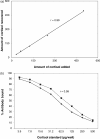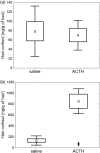Validation and use of hair cortisol as a measure of chronic stress in eastern chipmunks (Tamias striatus)
- PMID: 27293676
- PMCID: PMC4732495
- DOI: 10.1093/conphys/cou055
Validation and use of hair cortisol as a measure of chronic stress in eastern chipmunks (Tamias striatus)
Abstract
Stress levels of individuals are documented using glucocorticoid concentrations (including cortisol) in blood, saliva, urine or faeces, which provide information about stress hormones during a short period of time (minutes to days). In mammals, use of hair cortisol analysis allows for the assessment of prolonged stress over weeks and months and provides information on chronic stress levels without bias associated with handling. Here, we validate hair cortisol analysis in wild rodents using exogenous adrenocorticotrophic hormone (ACTH challenge) and apply the technique to evaluate stress in eastern chipmunks inhabiting logged and natural sites. Chipmunks were subjected to a mark-recapture study and injected weekly with ACTH (Synacthen Depot) or saline, with hair being collected at the conclusion of the challenge. Subsequently, faecal and hair samples were collected from chipmunks occupying logged and natural sites to assess the utility of hair cortisol in comparison with faecal cortisol metabolites. Following extraction, cortisol concentrations were quantified in hair and faecal extracts by enzyme immunoassay. Hair cortisol concentrations were significantly elevated in samples from ACTH-injected chipmunks compared with saline-injected control animals (five times higher). Chipmunks inhabiting logged sites had increased faecal cortisol metabolite concentrations compared with those in natural sites, but no differences were observed in hair cortisol concentrations. Faecal cortisol metabolite levels were positively correlated with hair cortisol levels in chipmunks. Hair cortisol levels reflect changes in circulating cortisol levels and can be used to evaluate the adrenal stress response, and thus stress, in natural populations. Nonetheless, because of the differences in the temporal scale of stress that hair and faeces represent, we caution the use of hair cortisol for detecting differences in physiological stress when comparing individuals within populations and suggest that it is best suited to examining population-level differences.
Keywords: ACTH challenge; faecal cortisol; logging.
Figures




Similar articles
-
Faecal metabolites and hair cortisol as biological markers of HPA-axis activity in the Rocky mountain goat.Gen Comp Endocrinol. 2019 Sep 1;280:147-157. doi: 10.1016/j.ygcen.2019.04.022. Epub 2019 Apr 19. Gen Comp Endocrinol. 2019. PMID: 31009603
-
The measurement of glucocorticoid concentrations in the serum and faeces of captive African elephants (Loxodonta africana) after ACTH stimulation.J S Afr Vet Assoc. 2000 Sep;71(3):192-6. doi: 10.4102/jsava.v71i3.712. J S Afr Vet Assoc. 2000. PMID: 11205170
-
Noninvasive monitoring of fecal cortisol metabolites in the eastern chipmunk (Tamias striatus): validation and comparison of two enzyme immunoassays.Physiol Biochem Zool. 2012 Mar-Apr;85(2):183-93. doi: 10.1086/664592. Epub 2012 Feb 7. Physiol Biochem Zool. 2012. PMID: 22418710
-
Stress Concepts and Applications in Various Matrices with a Focus on Hair Cortisol and Analytical Methods.Animals (Basel). 2022 Nov 10;12(22):3096. doi: 10.3390/ani12223096. Animals (Basel). 2022. PMID: 36428324 Free PMC article. Review.
-
Testing the Level of Cortisol in Dogs.Animals (Basel). 2025 Apr 23;15(9):1197. doi: 10.3390/ani15091197. Animals (Basel). 2025. PMID: 40362012 Free PMC article. Review.
Cited by
-
Methods of Assessment of the Welfare of Shelter Cats: A Review.Animals (Basel). 2020 Aug 28;10(9):1527. doi: 10.3390/ani10091527. Animals (Basel). 2020. PMID: 32872242 Free PMC article. Review.
-
Steroid hormones in hair reveal sexual maturity and competition in wild house mice (Mus musculus domesticus).Sci Rep. 2019 Nov 15;9(1):16925. doi: 10.1038/s41598-019-53362-4. Sci Rep. 2019. PMID: 31729421 Free PMC article.
-
No island-effect on glucocorticoid levels for a rodent from a near-shore archipelago.PeerJ. 2020 Feb 18;8:e8590. doi: 10.7717/peerj.8590. eCollection 2020. PeerJ. 2020. PMID: 32110493 Free PMC article.
-
Social relationship and hair cortisol level in captive male chimpanzees (Pan troglodytes).Primates. 2018 Mar;59(2):145-152. doi: 10.1007/s10329-017-0641-8. Epub 2017 Dec 15. Primates. 2018. PMID: 29247286
-
Detection of steroid and thyroid hormones in mammalian teeth.Conserv Physiol. 2021 Nov 24;9(1):coab087. doi: 10.1093/conphys/coab087. eCollection 2021. Conserv Physiol. 2021. PMID: 36439380 Free PMC article.
References
-
- Ashley NT, Barboza PS, Macbeth BJ, Janz DM, Cattet MRL, Booth RK, Wasser SK. (2011) Glucocorticosteroid concentrations in feces and hair of captive caribou and reindeer following adrenocorticotropic hormone challenge. Gen Comp Endocrinol 172: 382–391. - PubMed
-
- Ausband DE, Young J, Fannin B, Mitchell MS, Stenglein JL, Waits LP, Shivik JA. (2011) Hair of the dog: obtaining samples from coyotes and wolves non-invasively. Wildl Soc Bull 35: 105–111.
-
- Banks SC, Finlayson GR, Lawson GR, Lindenmayer DB, Paetkau D, Ward SJ, Taylor AC. (2005) The effects of habitat fragmentation due to forestry plantation establishment on the demography and genetic variation of a marsupial carnivore, Antechinus agilis. Biol Conserv 122: 581–597.
-
- Bates D, Maechler M, Bolker B, Walker S. (2013) lme4: linear mixed-effects models using Eigen and S4. R package version 1.0-4 http://CRAN.R-project.org/package=lme4.
LinkOut - more resources
Full Text Sources
Other Literature Sources

